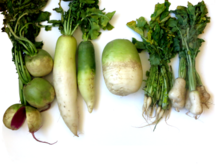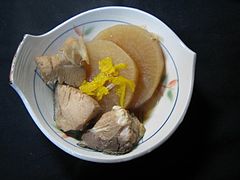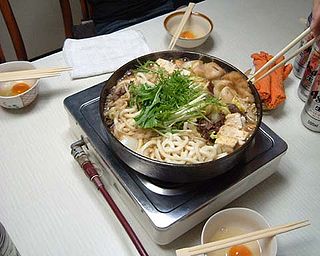
Nabemono,or simply nabe,is a variety of Japanese hot pot dishes,also known as one-pot dishes and "things in a pot".

The radish is a flowering plant in the mustard family,Brassicaceae. Its large taproot is commonly used as a root vegetable,although the entire plant is edible and its leaves are sometimes used as a leaf vegetable. Originally domesticated in Asia,radishes are now grown and consumed throughout the world. The radish is sometimes considered to form a species complex with the wild radish,and instead given the trinomial name Raphanus raphanistrum subsp. sativus.

Root vegetables are underground plant parts eaten by humans or animals as food. In agricultural and culinary terminology,the term applies to true roots such as taproots and tuberous roots as well as non-roots such as bulbs,corms,rhizomes,and stem tubers.
Northern root-knot nematode is a species of vegetable pathogens which produces tiny galls on around 550 crop and weed species. They invade root tissue after birth. Females are able to lay up to 1,000 eggs at a time in a large egg mass. By surviving harsh winters,they can survive in cold climates.
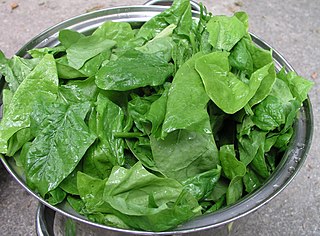
Leaf vegetables,also called leafy greens,pot herbs,vegetable greens,or simply greens,are plant leaves eaten as a vegetable,sometimes accompanied by tender petioles and shoots. Leaf vegetables eaten raw in a salad can be called salad greens.
The word "turnip" can refer to any of the following four vegetables:

Chai tow kway is a common dish or dim sum of Chaoshan cuisine in Chaoshan,China. It is also popular in Indonesia,Singapore,Malaysia,Thailand,Taiwan and Vietnam,consisting of stir-fried cubes of radish cake. In some places such as Singapore,it is confusingly and mistakenly translated as carrot cake.

Takuan,or takuan-zuke,known as danmuji (단무지) in the context of Korean cuisine,is a pickled preparation of daikon radish. As a popular part of traditional Japanese cuisine,takuan is often served uncooked alongside other types of tsukemono. It is also enjoyed at the end of meals to aid digestion.
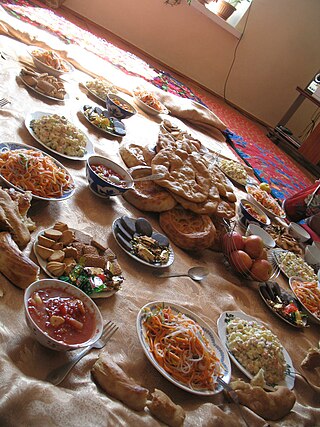
Central Asian cuisine has been influenced by Persian,Indian,Arab,Turkish,Chinese,Mongol,and Russian cultures,as well as the culinary traditions of other varied nomadic and sedentary civilizations. Contributing to the culinary diversity were the migrations of Uyghur,Slav,Korean,Tatar,Dungan and German people to the region.

Banchan are small side dishes served along with cooked rice in Korean cuisine. Banchan are often set in the middle of the table to be shared. At the center of the table is the secondary main course,such as galbi or bulgogi,and a shared pot of jjigae. Bowls of cooked rice and guk (soup) are set individually. Banchan are served in small portions,meant to be finished at each meal and replenished during the meal if not enough. Usually,the more formal the meals are,the more banchan there will be. Jeolla province is particularly famous for serving many different varieties of banchan in a single meal.

Turnip cake is a Chinese dim sum dish. The less common name radish cake is more accurate,as Western-style turnips are not used in the dish but rather shredded radish and plain rice flour. It is traditionally called carrot cake in Singapore.

The Sakurajima radish or Sakurajima daikon is a special cultivar of the Japanese radish named for its original place of cultivation,the former island of Sakurajima in Japan's Kagoshima Prefecture. It is the largest radish variety in the world. Its regular weight is about 6 kilograms (13 lb),although large ones can be as much as 27 kg (60 lb). It can grow as large as 50 cm (20 in) in diameter. It is also sometimes known in Japanese as shimadekon.
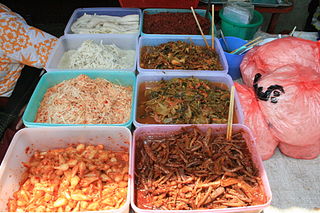
Mohnyin Tjin,is a popular Burmese cuisine fermented food dish of vegetables preserved in rice wine and various seasonings. It is similar to Korean Kimchi and Japanese Takana Tsukemono. Mohnyin Tjin is popularly associated with the Shan and is a ubiquitous condiment for Shan dishes such as meeshay and shan khauk swè.

Daikon is a generic term for radish in Japanese language. For example,European radish is called hatsukadaikon (廿日大根) in Japan. In the West,the word daikon sometimes refers to long white Asian radish varieties and sometimes Japanese radish varieties. When it is necessary to distinguish the usual Japanese form from others,it is sometimes known as Japanese radish or "true daikon".
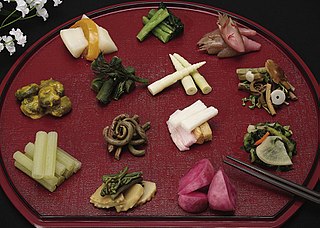
Tsukemono are Japanese preserved vegetables. They are served with rice as an okazu,with drinks as an otsumami (snack),as an accompaniment to or garnish for meals,and as a course in the kaiseki portion of a Japanese tea ceremony.

The black radish,a cultivated variety of the radish,is a root vegetable of the family Brassicaceae and is a variety of winter radish. It is also called black Spanish radish or Erfurter radish.
